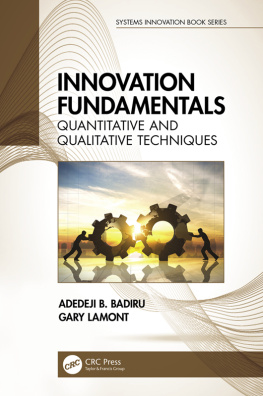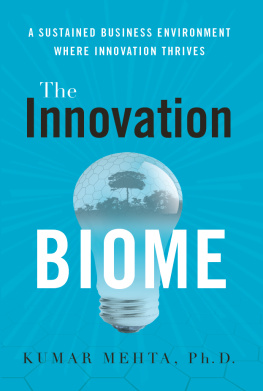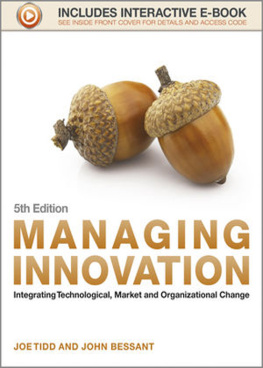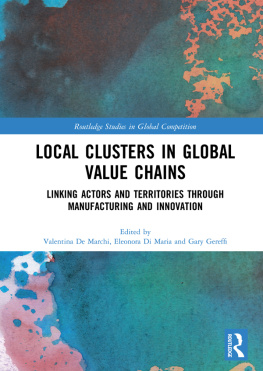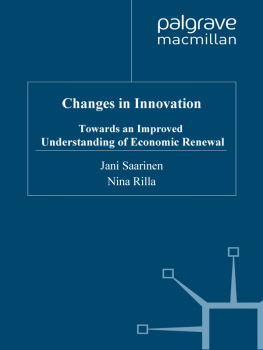GLOBAL COMPANIES, LOCAL INNOVATIONS
Global Companies, Local Innovations
Why The Engineering Aspects of Innovation Making Require Co-location
YASUYUKI MOTOYAMA
Kauffman Foundation, USA
ASHGATE
Yasuyuki Motoyama 2012
All rights reserved. No part of this publication may be reproduced, stored in a retrieval system or transmitted in any form or by any means, electronic, mechanical, photocopying, recording or otherwise without the prior permission of the publisher.
Yasuyuki Motoyama has asserted his right under the Copyright, Designs and Patents Act, 1988, to be identified as the author of this work.
Published by
Ashgate publishing Limited
Wey Court East
Union Road
Farnham
Surrey, GU9 7PT
England
Ashgate Publishing Company
Suite 420
101 Cherry Street
Burlington
VT 05401-4405
USA
www.ashgate.com
British Library Cataloguing in Publication Data
Motoyama, Yasuyuki.
Global companies, local innovations : why the engineering aspects of innovation making
require co-location. (Ashgate economic geography series)
1. International business enterprises-Location. 2. Industrial location-Effect of labor
market on. 3. Product design. 4. New products-International cooperation. 5. Toyota
Jidosha Hanbai Kabushiki Kaisha. 6. Soni Kabushiki Kaisha. 7. Kyanon Kabushiki
Kaisha.
I. Title II. Series
338.8'81-dc23
Library of Congress Cataloging-in-Publication Data
Motoyama, Yasuyuki.
Global companies, local innovations : why the engineering aspects of innovation making require co-location / by Yasuyuki Motoyama.
p. cm. (Ashgate economic geography series)
Includes index.
ISBN 978-1-4094-2146-7 (hardback : alk. paper) ISBN 978-1-4094-2147-4 (ebook) 1.
International business enterprises. 2. Industries-Effect of technological innovations on.
3. Commercial geography. I. Title.
HD2756.M68 2012
338'.064-dc23
2012012007
ISBN 9781409421467 (hbk)
ISBN 9781409421474 (ebk-PDF)
ISBN 9781409483731 (ebk-ePUB)

Printed and bound in Great Britain by the MPG Books Group, UK
Contents
List of Figures
List of Tables
List of Abbreviations
ADR | American Depository Receipt |
AV | Audio Visual |
CAD | Computer Aided Design |
CAE | Computer Aided Engineering |
CEO | Chief Executive Officer |
COO | Chief Operating Officer |
CPU | Central Processing Unit |
DEC | Digital Equipment Corporation |
DRAM | Dynamic Random Access Memory |
ECU | Electric Control Unit |
HDD | Hard Disc Drive |
HP | Hewlett-Packard |
IBM | International Business Machine |
IPO | Initial Public Offering |
LCD | Liquid Crystal Display |
LSI | Large-Scale Integrator |
MNC | Multinational Corporation |
MPG | Miles per Gallon |
OEM | Original Equipment Manufacturing |
OS | Operation System |
RE | Resident Engineer |
RQ | Research Question |
SE | Simultaneous Engineering |
SEC | Securities and Exchange Commission |
TFP | Total Factor Productivity |
VAIO | Video Audio Integrated Operation |
VVTi | Variable Valve Timing Organization |
Acknowledgments
This book project could not have been completed without the help, encouragement, and cooperation I received from my teachers and friends. I am grateful for the circle of my advisers: Karen Chapple, Steve Cohen, David Dowall, Steven Vogel, and most invaluably, AnnaLee Saxenian.
I was privileged to meet a cluster of great scholars and friends at Berkeley, and am grateful for the relationship and friendship since then: Manuel Castells, Mike Teitz, Robert Cole, T.J. Pempel, Martin Kenney, Susan Helper, David Mowery, Peter Evans, and Youtien Hsing. Friends include Makiko Takekuro, Keiko Hjersman, Victor Polanco, Alberto DiMinin, Gary Fields, Lee Chung-Kai, Xiaohong Quan, Liang-Chih Chen, Wang Jenn-Hwan, Qing, Bradley Flamm, Neil Hrushowy, Pitch Pongsawat, Vikki Chanse, Kenji Kushida, and Yumiko Mikanagi.
Shuzo Katsumoto opened the door to my research by coordinating interviews with his company. I enjoyed the informal conversation with Eishi Endo that first hinted to me about the existence of an unglobalized dimension of R&D. Yukihisa Hayakawa and Jennifer Y. Ishiguro provided insights and coordination with their company. Aki Shoji was a brilliant professional who tested and supported my earlier ideas. I appreciate all interviewees for their cooperation despite their being so busy.
I am fortunate to have had an even greater circle of intellectuals after I left Berkeley. Michael Storpers seminar became an important asset to me. I appreciated comments about a chapter from David Rigby and suggestions about publication from Alan Scott and Ann Markusen. Beth Chapple and Toddie Downs patiently reviewed my manuscript. Katy Crossan and Lianne Sherlock always responded promptly and coordinated professionally. Matt Eisler, Mikael Johansson, Jennifer Rogers, and Gwen DArcangelis were wonderful post-doc colleagues. Rich Appelbaum, Barbara Harthorn, and Patrick McCray were excellent supervisors.
Lastly and most importantly, I have to thank my family. My parents supported me throughout the graduate school, as well as the post-doctoral period. My wife, Michelle Johnson, was always the first and last person that I could consult with my ideas. It was the intellectual dinner discussion I could have with her, the morning smile she gave me, and afternoon tea conversation we shared in our study room that inspired and improved this manuscript. Those intellectual and private times seem a distant memory, as we now have two little children, Kai and Elyse, but they give me the inspiration to write, to research, and to live. Thank you.
August 2012
Lawrence, Kansas
Y.M.
Preface
The research in this book started as a personal inquiry. I was a doctoral student at the University of California, Berkeley, and was eager to explore the grand concept of globalization. Given my interests in the high-tech sector and research and development (R&D) activities, I wanted to see where and how firms globalize their R&D operations.
Berkeley was a global laboratory for me. With its world renown, its strengths in engineering and the natural sciences, and its prime location in Silicon Valley, the university hosted engineers and managers from companies around the world. With my Japanese background, the doors were open to some of the most globally operating firms. I was fortunate to meet people from Sony, Hitachi, Olympus, and NTT, to name a few, and I started to ask questions. How does your firm globalize your R&D activities? What does your R&D center in Silicon Valley do? What products came out of the overseas R&D labs? How do you coordinate the process?
Next page

